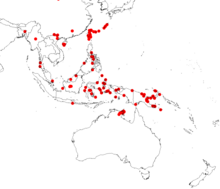| Parsonsia alboflavescens | |
|---|---|

| |

| |
| from Icones Plantarum Indiae Orientalis, vol. 4(2): t. 1303 (1846) | |
| Scientific classification | |
| Kingdom: | Plantae |
| Clade: | Tracheophytes |
| Clade: | Angiosperms |
| Clade: | Eudicots |
| Clade: | Asterids |
| Order: | Gentianales |
| Family: | Apocynaceae |
| Genus: | Parsonsia |
| Species: | P. alboflavescens
|
| Binomial name | |
| Parsonsia alboflavescens | |

| |
| Occurrence data from GBIF | |
| Synonyms[4] | |
|
List
| |
Parsonsia alboflavescens is a woody vine of the family Apocynaceae,[2][4] found from tropical and subtropical Asia to Northern Australia.[4] In the Northern Territory of Australia, where it occurs in Arnhem Land, it has been declared "near threatened".[1]
Taxonomy
Parsonsia alboflavescens was first described in 1818, by Dennstedt, as Periploca alboflavescens.[5][6] It was described many times.[4] The current name is that given by Mabberley in 1977,[2] who, working through the many names, found that Dennstedt's publication preceded all others, which meant that this Parsonsia took the species epithet, alboflavescens.[3]
Type illustrations
(See Middleton.)[7]
- Rheede tot Drakestein, H.A. van, Hortus Indicus Malabaricus, vol. 9: t. 9 & 10 (1689)
-
-
Etymology
Robert Brown gave the generic name, Parsonsia, to honour James Parsons (1705–1770).[8][9] The species epithet, alboflavescens, is derived from the Latin albus (white). flavescens (turning yellow, becoming yellow) and refers to the flower.[10]
References
- ^ a b FloraNT Northern Territory Flora online: Parsonsia alboflavescens. Accessed 24 December 2018.
- ^ a b c "Parsonsia alboflavescens". Australian Plant Name Index, IBIS database. Centre for Plant Biodiversity Research, Australian Government. Retrieved 24 December 2018.
- ^ a b Mabberley, D.J. (1977). "Francis Hamilton's Commentaries with Particular Reference to Meliaceae". Taxon. 26 (5/6): 523–540. doi:10.2307/1219645. ISSN 0040-0262. JSTOR 1219645. JSTOR
- ^ a b c d Govaerts, R. et al. (2018) Plants of the world online: Parsonsia alboflavescens. Board of Trustees of the Royal Botanic Gardens, Kew. Retrieved 24 December 2018.
- ^ Dennstedt, A.W. (1818) Schlussel zum Hortus indicus Malabaricus: 12, 23, 35.
- ^ "Periploca alboflavescens". Australian Plant Name Index, IBIS database. Centre for Plant Biodiversity Research, Australian Government. Retrieved 24 December 2018.
- ^ Middleton, D.J. (1997)"A revision of Parsonsia R. Br. (Apocynaceae) in Malesia". Blumea (1): 191–246. Retrieved 24 December 2018. ISSN 0006-5196
- ^ "Parsonsia". Australian Plant Name Index, IBIS database. Centre for Plant Biodiversity Research, Australian Government. Retrieved 24 December 2018.
- ^ Brown, R. (1810) On the Asclepiadeae: 53.
- ^ Plantillustrations.org Parsonsia alboflavescens (Dennst.) Mabb. Retrieved 24 December 2018.



